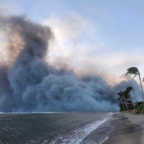
Its reputation as a romantic island paradise is legendary, but Hawaii is facing an embarrassing problem with its sewage which could cost around $1.75 billion to fix. Surfers and snorkellers have fallen victim to skin infections and the state’s drinking water, its coral reefs and famous beaches are all under threat because of a cesspool crisis.
Cesspools are holes in the ground where untreated human waste is deposited and this waste is entering the drinking water in part of the state — pushing nitrate levels close to the legal limit.
According to the state health department, the state now has 88,000 cesspools across its eight major islands, more than any other state in the US.
As the state’s politicians scramble to find a solution, the report states that the cost of replacing each cesspool could reach around $1.75 billion.
Worryingly, more than 90 percent of the state’s drinking water comes from groundwater wells, but these cesspools deposit 53 million gallons of raw sewage into the ground every day.
“Cesspools also present a risk of illness to island residents and a significant harm to streams and coastal resources, including coral reefs,” a new report from the department stated.
“Cesspool effluent (liquid waste) poses significant threats to human health and sensitive ecosystems. Cesspool wastewater is untreated and contains pathogens, bacteria and viruses that may spread disease.
“Additionally, cesspool effluent contains nutrients, like nitrogen and phosphorous, that can disrupt the sensitive ecosystems of Hawaii.”
The report states that the replacement of cesspools would take years.
“Replacement of each existing cesspool with an improved treatment method could cost $20,000 or more per system, for a total cost around $1.75 billion for the 87,900 currently inventoried cesspools,” it reads.
The report states that cesspools can affect humans by either overflowing and exposing us to waste directly or the leaching of liquid waste into the groundwater — which can transport cesspool contamination over “significant distances”.
One of the main risks is the contamination of drinking water sources which could allow pollutants, including pathogens, to enter the human body.
“Additionally, cesspools introduce excess nitrogen into the environment,” the report reads. “Elevated nitrate levels in drinking water is a known human health risk in drinking water.”
At one groundwater well, nitrate levels are already at 8.7 milligrams a liter. The legal limit is 10 and the Department of Health estimated that some parts of the aquifer are already over that limit.
The department also states that the crisis is threatening Hawaii’s famous beaches, coastal waters and marine life — which could deal a devastating blow to its crucial tourism economy.
This is because nutrients including nitrogen and phosphorus in cesspool waste can “promote” algae growth that degrades water quality and clarity.
“The natural ecosystem of Hawaii is low in nutrients and coral reefs specifically thrive in low-nutrient waters,” the report reads.
“The cumulative loading of nitrogen and phosphorous from all cesspools in a watershed is delivered to nearshore waters and can result in ecosystem shifts from a coral-dominated ecosystem to one dominated by macroalgae.
“The impacts to coral reefs affects the State’s economy, shoreline protection, recreation and habitat for important marine life.”
Peter Hackstedde, president of a community group on the state’s largest island, told The Wall Street Journal he now avoids the water if he has a cut because he has been infected before.
He said the community had already spent more than $2.5 million of its own money just to study the problem.
“We found that sewage is leaking into the ocean and we swim in it,” Hackstedde told the Journal.
“Everyone who lives down here is pretty much for cleaning up the ocean. We just need the money.”















Social Profiles